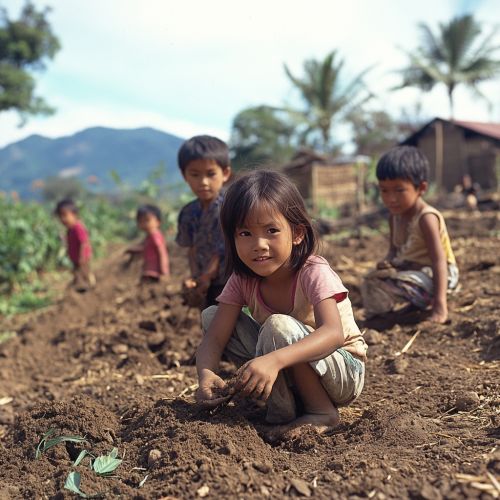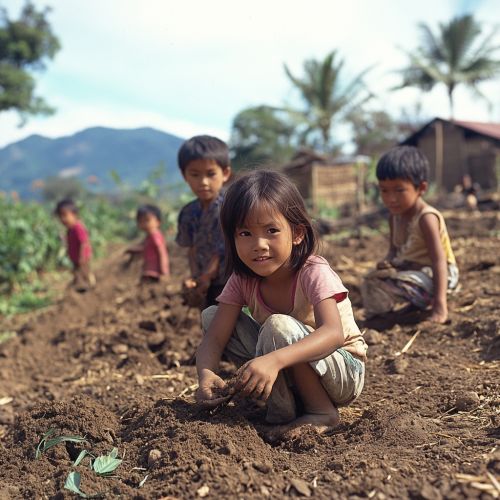Child trafficking: Difference between revisions
(Created page with "== Introduction == Child trafficking is a severe violation of human rights that involves the recruitment, transportation, transfer, harboring, or receipt of children for the purpose of exploitation. This illicit activity is a subset of human trafficking and is recognized as a global issue that affects millions of children worldwide. Child trafficking can take many forms, including forced labor, sexual exploitation, and the use of children in armed conflicts. The complexi...") |
No edit summary |
||
| Line 17: | Line 17: | ||
Child marriage is another form of child trafficking where children, predominantly girls, are forced into marriage. This practice is often driven by poverty, cultural traditions, and gender inequality. Child brides are at a higher risk of domestic violence, sexual abuse, and health complications related to early pregnancy. | Child marriage is another form of child trafficking where children, predominantly girls, are forced into marriage. This practice is often driven by poverty, cultural traditions, and gender inequality. Child brides are at a higher risk of domestic violence, sexual abuse, and health complications related to early pregnancy. | ||
[[Image:Detail-97451.jpg|thumb|center|Children in a rural setting, engaged in forced labor.|class=only_on_mobile]] | |||
[[Image:Detail-97452.jpg|thumb|center|Children in a rural setting, engaged in forced labor.|class=only_on_desktop]] | |||
== Causes and Risk Factors == | == Causes and Risk Factors == | ||
Latest revision as of 00:52, 3 August 2024
Introduction
Child trafficking is a severe violation of human rights that involves the recruitment, transportation, transfer, harboring, or receipt of children for the purpose of exploitation. This illicit activity is a subset of human trafficking and is recognized as a global issue that affects millions of children worldwide. Child trafficking can take many forms, including forced labor, sexual exploitation, and the use of children in armed conflicts. The complexity and clandestine nature of child trafficking make it a challenging issue to address, requiring coordinated international efforts and comprehensive legal frameworks.
Forms of Child Trafficking
Child trafficking manifests in various forms, each with distinct characteristics and implications for the victims. Understanding these forms is crucial for developing effective prevention and intervention strategies.
Forced Labor
Forced labor involves the exploitation of children in various industries, including agriculture, manufacturing, mining, and domestic work. Children are often subjected to hazardous conditions, long working hours, and minimal or no remuneration. The International Labour Organization (ILO) estimates that millions of children are engaged in forced labor worldwide.
Sexual Exploitation
Sexual exploitation is one of the most pervasive and damaging forms of child trafficking. Victims are coerced into prostitution, pornography, and other forms of sexual abuse. Traffickers often use manipulation, threats, and violence to control the children. The psychological and physical impacts on the victims are profound and long-lasting.
Child Soldiers
In conflict zones, children are recruited, often forcibly, to serve as soldiers, spies, messengers, or human shields. These child soldiers are exposed to extreme violence and are often forced to commit atrocities. The use of child soldiers is a grave violation of international law, including the United Nations Convention on the Rights of the Child.
Child Marriage
Child marriage is another form of child trafficking where children, predominantly girls, are forced into marriage. This practice is often driven by poverty, cultural traditions, and gender inequality. Child brides are at a higher risk of domestic violence, sexual abuse, and health complications related to early pregnancy.


Causes and Risk Factors
Several factors contribute to the prevalence of child trafficking, including socio-economic, cultural, and political elements.
Poverty
Poverty is a significant driver of child trafficking. Families in impoverished conditions may be more susceptible to traffickers' promises of better opportunities for their children. Economic desperation can lead parents to unknowingly sell their children into exploitative situations.
Lack of Education
A lack of education and awareness about the dangers of trafficking makes children more vulnerable. Education can empower children and communities to recognize and resist trafficking attempts.
Political Instability
Regions experiencing political instability, armed conflict, or weak governance are hotspots for child trafficking. The breakdown of social and legal structures creates an environment where traffickers can operate with impunity.
Cultural Norms
Certain cultural practices and norms, such as child marriage and bonded labor, perpetuate the exploitation of children. These practices are often deeply ingrained and challenging to eradicate.
Legal Frameworks and International Efforts
Addressing child trafficking requires robust legal frameworks and international cooperation. Several international treaties and conventions aim to combat child trafficking and protect the rights of children.
United Nations Protocol to Prevent, Suppress and Punish Trafficking in Persons
The United Nations Protocol to Prevent, Suppress and Punish Trafficking in Persons, especially Women and Children, also known as the Palermo Protocol, is a key international instrument. It provides a comprehensive framework for preventing trafficking, protecting victims, and prosecuting traffickers.
Convention on the Rights of the Child
The United Nations Convention on the Rights of the Child (CRC) is a fundamental treaty that outlines the rights of children and the obligations of states to protect these rights. The CRC includes specific provisions related to the protection of children from exploitation and trafficking.
International Labour Organization Conventions
The ILO has established several conventions aimed at combating child labor and trafficking, including Convention No. 182 on the Worst Forms of Child Labour and Convention No. 138 on the Minimum Age for Admission to Employment.
Prevention and Intervention Strategies
Effective strategies to combat child trafficking involve prevention, protection, and prosecution.
Prevention
Prevention efforts focus on addressing the root causes of child trafficking, such as poverty and lack of education. Community awareness programs, economic support for vulnerable families, and educational initiatives are critical components of prevention.
Protection
Protection measures aim to safeguard victims and provide them with the necessary support and rehabilitation. This includes providing safe shelters, medical care, psychological support, and legal assistance. Child protection systems must be strengthened to ensure the safety and well-being of trafficking victims.
Prosecution
Prosecution involves the legal pursuit of traffickers to hold them accountable for their crimes. Strengthening law enforcement capabilities, enhancing judicial processes, and ensuring that traffickers face appropriate penalties are essential for deterrence and justice.
Challenges and Barriers
Despite significant efforts, several challenges and barriers hinder the fight against child trafficking.
Identification of Victims
Identifying victims of child trafficking is a complex task due to the clandestine nature of the crime. Victims may be hidden, isolated, or manipulated into not seeking help. Effective identification requires trained professionals and comprehensive screening processes.
Cross-Border Trafficking
Child trafficking often involves cross-border movements, complicating jurisdictional and legal responses. International cooperation and coordination are crucial to address cross-border trafficking effectively.
Corruption
Corruption within law enforcement and governmental institutions can undermine anti-trafficking efforts. Traffickers may bribe officials to avoid detection and prosecution, perpetuating the cycle of exploitation.
Limited Resources
Many countries, particularly those with high rates of trafficking, lack the resources and infrastructure to combat the issue effectively. International support and funding are necessary to bolster local efforts.
Conclusion
Child trafficking is a multifaceted and deeply entrenched issue that requires a comprehensive and coordinated response. By understanding the various forms of trafficking, addressing the root causes, and strengthening legal and protective measures, the global community can work towards eradicating this grave violation of children's rights.
